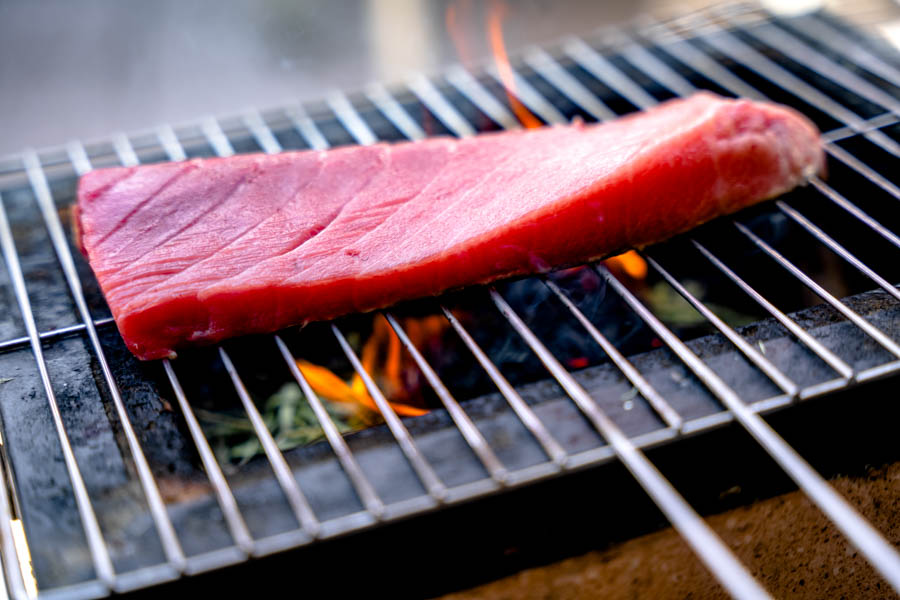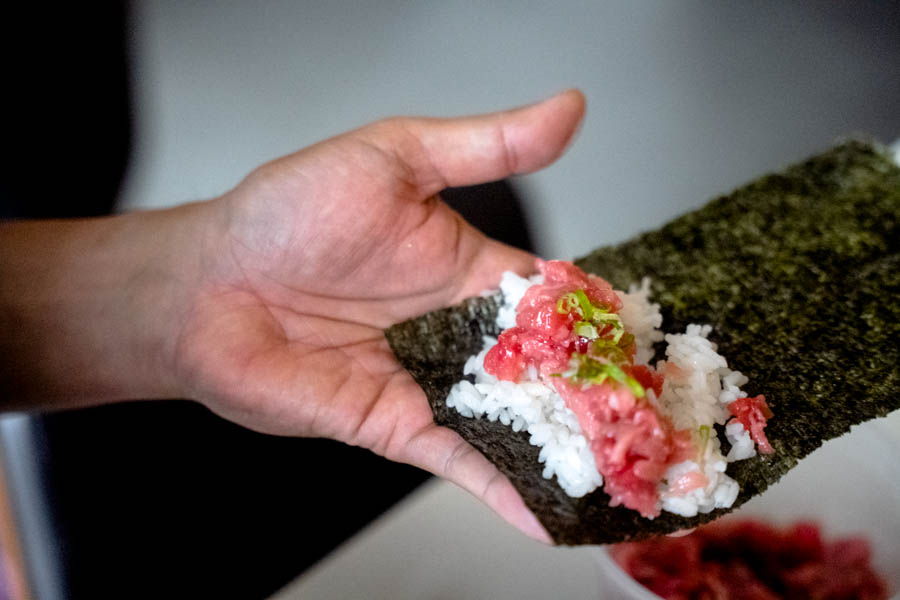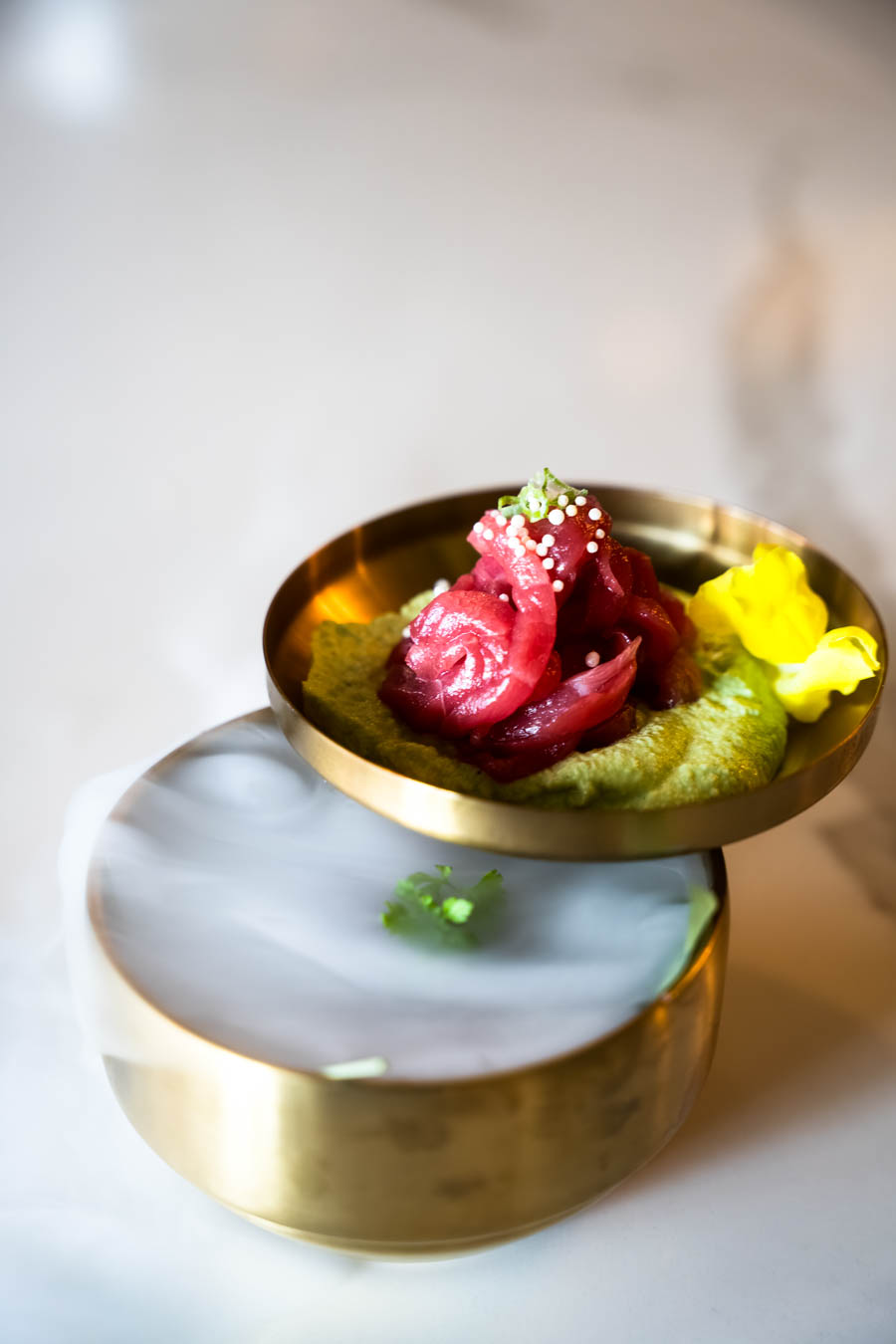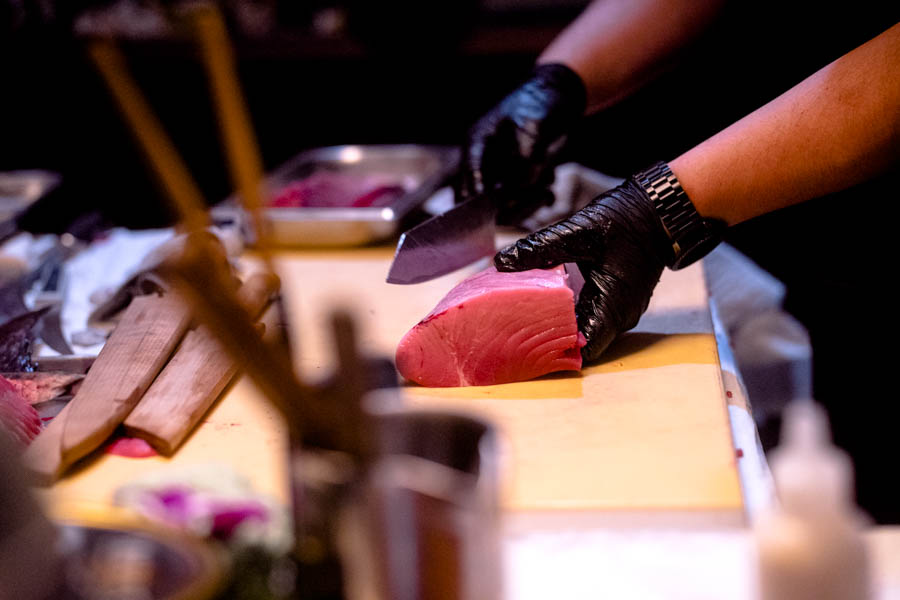On a warm spring evening, guests crowd the back room of JPAN Sushi & Grill at University Town Center. Bunched together like sardines, they hold up their phones hoping to capture a shot of the night’s star attendee. I stand a few rows deep into the group and crane my neck to get a better angle. When I catch a glimpse of the VIP guest, I gasp. Amidst a throng of people—many die-hard sushi enthusiasts—I’m witnessing the transformation of a 170 lb. Pacific bluefin tuna into an inventive eight-course meal that calls upon hundreds of years of sushi mastery to give diners an unforgettable experience. A special event put on by JPAN, this Bluefin Tuna Cutting draws in sushi fanatics living in Sarasota and those from cities farther along the Gulf Coast, like Tampa. “We want to share Japanese culture with guests and help them feel the love that the chefs put into the dishes,” says Daniel Dokko, the restaurant’s owner and chef.
I take my seat, sandwiched in between two couples that have chosen this event for their special occasion dinners. The husband from the pair to my right regales me with tales of his previous attendance at similar events, known as omakase, in which the chef’s whims drive the menu. As there is no set menu from which guests choose, they put their trust in the chef to deliver them an exquisite meal.

While I enjoy a good California or crispy tempura roll, I’ve shied away from the likes of raw fish and caviar. Listening to my tablemate express his hope to sample JPAN’s sashimi, or slices of fresh raw fish, I hold my chopsticks like a battle weapon. My five-dollar Publix sushi lunches have left me unprepared for what’s to follow. Dokko makes the rounds in the dining room, stopping by each table to welcome and check on guests. When he reaches me, I fear he’ll realize that I’m an imposter, stumbling over the pronunciation of basic styles of sushi.
Instead, he asks if I’ve ever had tuna before, at which I relax into my seat. “Yes, but only from a can,” I say. “This is a different kind of tuna,” he says, his face at once mournful for my deprivation from the bluefin variety but eager to watch me taste it for the first time.
Fifteen species of tuna roam the open seas, but the bluefin ranks among the most coveted. The fish’s higher fat content infuses the meat with a buttery flavor. “About 15 years ago, the bluefin was endangered and being overfished,” says Dokko. “If someone caught one, they’d ship it to Japan because it not only consumes more bluefin than any other country but is also willing to pay more for the product.” Innovations in aquaculture and industry control have spurned sustainable fishing efforts, allowing restaurants to choose between line-caught and farm-raised varieties. The Spanish company Balfegó, which has supplied tuna to JPAN in the past, is an aquaculture pioneer, catching only adult Atlantic bluefins who populate their farms. JPAN paid a little over $4,000 for the fish that I’m gearing up to eat—and that fish is on the smaller side. Their menu features bluefin tuna on special occasions, and the chefs must put a great deal of thought into preparing and serving the fish.

“This fish was line-caught off of Mexico and is smaller than farm-raised ones. We need to use the whole fish within five days, and we don’t want any to go to waste,” adds Dokko. Even with a smaller fish, his team still has their work cut out for them.
“Not many chefs have the opportunity to work with a whole tuna. It’s hard for restaurants to order one, so they often order tuna loins, or parts of the tuna, to avoid having to worry about not using the entire fish.” Dokko and his partner have over two decades of experience in cutting a whole tuna and have learned from their mistakes. “We don’t want to make a mistake cutting it because we could lose a lot of the meat,” he says. “35 percent of that tuna becomes waste in the form of bones, the head, fins and tail, so there’s no room for error.”
For sushi chefs, practice is key. In Japan, students attend special sushi schools, devoting themselves to the art for a period of 4-5 years with the goal of becoming an itamae, the head sushi chef. Coming up in the American restaurant scene, Dokko underwent a more informal training process. While working as a dishwasher in a Japanese restaurant in Orlando, Dokko trained under the restaurant’s owner, learning the intricate step-by-step process that goes into perfecting the dish.
“I started by making rice, which is the most important part of sushi. The rice has to be cooked properly with the correct amount of seasoning. It can’t be mushy.” Sushi has been around in Japan for hundreds of years, but the modern iteration with sticky rice sprang up around the 1820s. According to BBC Ideas, chefs had discovered that it was possible to speed up the rice preparation process and serve fresh raw fish atop the rice. In centuries past, Japanese chefs used rice to ferment fish, which could take months. The rice had an unpleasant flavor, so it was tossed aside. But the new cooking methods meant that the sticky rice could be elevated and take on a leading role in the dish. “I probably cooked thousands and thousands of batches of rice,” Dokko says.
Once a student has mastered rice cooking, they move on to learning how to roll the sushi, another exercise in patience and skill. “Sushi rolls look easy, but you have to know how much rice to put on the nori or seaweed, and how to roll it tight enough that nothing falls out.” Sampling the hand rolls served as two different courses during the meal, I appreciate the extra effort.

Hand rolls, a little like sushi burritos, are uncut sushi rolls that guests can pick up and eat with their hands. Seeing that hand rolls are rising in popularity in larger cities, Dokko is eager to introduce them to Sarasota. “What’s different about the hand roll is the nori. It’s more expensive and higher quality. We hope to serve hand rolls made tableside so that the nori stays crispy.” In the spicy tuna and warm crab salad hand roll, the heat of the tuna contrasts with the cool, sticky rice, all encapsulated in a crunchy nori shell. I devour this roll, marveling at the texture of the seaweed. Most sushi that I’ve had features a more chewy type of nori, which would be difficult to eat by hand. “It’s not about the roll itself, but about what chefs are putting into it,” adds Dokko. The spicy tuna is smooth and melts on my tongue, making me wonder why I’ve been so hesitant to try the fish in its purest raw form.
I get another chance with the final course, the sashimi plate. Three cuts of lean, medium and fatty tuna ranging from pink to deep red sit in front of me on a blue floral patterned dish. Their clean edges showcase the chefs’ years of training to properly cut fish. Everyone else digs in, despite remarking after the first seven courses that they’re stuffed. I call to mind Dokko’s presentation at the beginning of the night, breaking down the process of cutting the fish in the correct manner. Chefs cut the tuna into four quadrants or loins. While almost all other types of fish must be frozen to kill parasites before being served to guests, tuna is a rare exception. A myriad of factors, from the fish’s tendency to swim in deep ocean waters with less exposure to parasites and modern fishing quality control methods mean that diners like me can enjoy the sashimi at its freshest.
Over sliced cantaloupe, I marvel at everything I’ve had the opportunity to try. Sea urchin, or uni, wagyu beef, caviar and shiso leaves left my mouth watering, but, as Dokko expected, the bluefin tuna swam circles around its canned cousins. “The sashimi is supposed to bring the wow factor,” he says. “You get to eat three cuts of the fish you just watched being cut. It’s the main event.”










